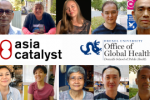Microbicide gel: A major breakthrough in AIDS fight
In one of the most attention-grabbing
sessions of the conference, the Center for the AIDS Program of Research in
South Africa reported that a clinical study of 889 women has found that a microbicide
gel used before and after sex could reduce risk of HIV infection by nearly 40
percent. The findings are especially encouraging
as six previous microbicide trials have failed over the past fourteen years.
The self-applied gel could make it possible for women to reduce the risk of HIV
infection.
杀微生物凝胶:艾滋病战役中的主要突破
在其中一场引人注目的会议中,南非艾滋病研究项目中心报告道,通过对889名妇女进行临床研究,他们发现妇女在性活动前后使用一种杀微生物凝胶后,其感染艾滋病病毒的风险将降低40%。在经历过去14年来,
6次杀微生物剂研制的失败之后,这次的发现令人精神为之一振,这种可自主使用的凝胶使得降低妇女感染艾滋病的风险成为可能。
Although the results appear promising,
researchers noted that more tests must be conducted, more protective
formulations of the gel must be found, and marketing must be tailored to the
women who will use it. The gel’s effectiveness must still be confirmed in a
larger clinical trial, which is currently under way. Researchers are also
exploring more potent formulations that would provide an even greater reduction
in the risk of HIV transmission.
“The gel is not perfect. But for the first time in the fight to
control the global epidemic, it offers women a way to protect themselves even
without the cooperation of their male partners,” according to a New
York Times editorial. Women make up
half of the roughly 33 million people who are HIV-positive, and as South
African AIDS activist Vuyiseka Dubula pointed out, “When women want to engage in sex,
we don’t want to spend the time negotiating safety.”
In a time of limited financial and
political resources, a microbicide gel is a cost-effective, promising
prevention strategy. It will take time, however, for the microbicide gel to
undergo further testing and become available to women who need it.
这项发现确实鼓舞人心,不过研究者们指出,需要开展更多的测试,需要研制更多该类凝胶的保护性配方,需要调整有关市场,使其适应于需要使用该类凝胶的妇女。凝胶的有效性还有待于正在进行的更大规模临床试验的确认,研究者们仍旧在研究更多药效更强的药剂,以求在更大程度上降低感染艾滋病的风险。
“虽然这类凝胶还不完美,但在控制这个全球性传染病的战役中,它第一次给妇女们提供了一种可以在男伴不合作的情况下保护自己的方法。”《纽约时报》的一篇社论如此说。妇女占了大约三千三百万艾滋病呈阳性的人员的一半,正如南非艾滋病活动家乌伊瑟卡·杜布拉所指出的一般,”如果妇女们想要一次性生活,我们是不想花时间讨论安全问题的。”
在财政和政治资源有限的当下,杀微生物凝胶将是一项花费有效且颇具前途的预防战略。不过,要对凝胶开展更深入的研究并使需要它的妇女能利用它,还需要一定的时间。
Microbicide
advances give Pre-Exposure Prophylaxis momentum
The success of the CAPRISA microbicide
study has had a positive impact on other new prevention strategies, including Pre-Exposure
Prophylaxis (PrEP). PrEP is a
treatment-as-prevention approach where an HIV-uninfected person takes an oral
pill to prevent infection.
Giving medicine to those who are
uninfected is not a new concept. It is a
common prevention strategy for malaria. But the recent success of microbicide
research has raised expectations for PrEP.
If successful, PrEP would benefit all at-risk populations but is
especially promising for women, who urgently need prevention methods that they
can control independently of men.
Currently, scientists are conducting PrEP trials in Botswana, Brazil,
Ecuador, Kenya, Malawi, Peru, Thailand, Uganda and the United States.
Despite the renewed push behind PrEP,
the experimental approach is not without controversy. Concerns remain regarding the side effects of
taking an ongoing drug. Increased drug resistance and the harm that can be
caused by non-adherence are also issues of concern to scientists. The most
vocal concern remains one of funding: if there is already limited access to
funding for HIV treatment for those who are already living with HIV, how can
the drugs be provided to those who are uninfected as well?
Leading journalist Jon Cohen noted
that funding was a valid concern but that the debate was premature. “The argument that
prevention somehow competes with treatment funding is kind of the oldest,
silliest argument in the field,” he said.
“[But] we have to see what the clinical trials show, if it works and how
it works under what conditions. Then
let’s worry about the money.”
杀微生物剂研发的前进成为治疗性预防的助动力
CAPRISA杀微生物剂研制的成功对其他预防策略有着积极影响,包括治疗性预防措施(PrEP)在内,PrEP是一项以治为防的措施,它是指通过让未感染艾滋病的人员口服药片的方式避免感染。
向未被感染者提供药品不是一个新概念,它是疟疾治疗的一种常用策略。最近在杀微生物剂研究上的成功提高了人们对PrEP的期望。如果PrEP能成功,它将为易感人群带来福音,尤其是那些急切需要获得独立于男性的预防方法的妇女。目前,科学家们正在博茨瓦纳、巴西、厄瓜多尔、肯尼亚、马拉维、秘鲁、泰国、乌干达和美国展开PrEP的试验。
尽管PrEP有了新的推动力,但是试验中矛盾犹存。对持续服用一种药物会产生的副作用的忧虑依旧存在,不坚持服药带来的不断增强的抗药性和危害也是科学家们关注的话题。而引起最多关注的是资金的问题,如果对那些已经患有艾滋病的患者,所能提供的用于治疗的资金尚且有限,我们又如何向那些还未受感染的人群提供药物治疗?
首席记者约翰·克亨指出,资金问题是一个有意义的问题,但是讨论尚欠成熟,”关于预防资金和治疗资金之间的比较是该领域一项最古老的却又最傻的讨论,”他说,”我们需要知道临床试验的结果如何,是否有效,在哪种情形下有效,然后,我们再来担心钱的问题。”
UNITAID
Patent Pool could improve access to ARVs
Ellen ‘t Hoen of UNITAID spoke about
the Medicines Patent Pool, which will allow patent holders to voluntarily offer the
intellectual property related to ARVs under certain conditions. Any company wishing to use the intellectual
property to produce the drugs can do so in exchange for a royalty payment. ‘t Hoen noted that if licenses for patents on
AIDS drugs are not made available in countries that grant patents, generic
competition will no longer be able to play a role in bringing down prices.
Over the past 10 years, activism,
generic competition for medications, the development of fixed-dose
combinations, and many countries’ willingness to use flexibilities in national
and international patent rules have greatly increased access to ART. However, many patients will soon need to
switch to much more expensive second- and third-line drugs, and the WHO is
recommending newer, safer, patent-protected medications.
By making licenses available and
harnessing the power of competition in medicines markets, the patent pool could
promote the availability of better and more robust treatments and generate
considerable cost savings.
联合救助中心专利池能够改善获得抗逆转录病毒疗法(ARVs)的途径
联合救助中心(UNITAID)的艾凌特·赫恩谈论了有关药物专利池的事情,通过药物专利池,专利拥有者可以将和ARVs疗法相关的知识产权在一定条件下自愿转让,任何一家希望利用该知识产权生产药品的公司也可通过付专利费的方式获准生产。艾凌特·赫恩注意到,如果治疗艾滋病药物的专利许可不被专利授予国认可,基因竞赛也将不再能起到降低价格的作用。
在过去十年里,活动家、药用基因竞赛,固定剂量联合的发展以及许多国家对灵活应用国内国际专利规则的意愿,都极大地增加了ARVs的获取途径。然而,由于许多病人即将转而使用更贵的二线、三线药物,世界健康组织提倡新的、更安全的、受专利保护的药物。
专利池通过让许可证成为可能,增强药品市场中竞争的力量,可以推动更好、更强效的治疗方式的利用,并极大地减少了开支。




